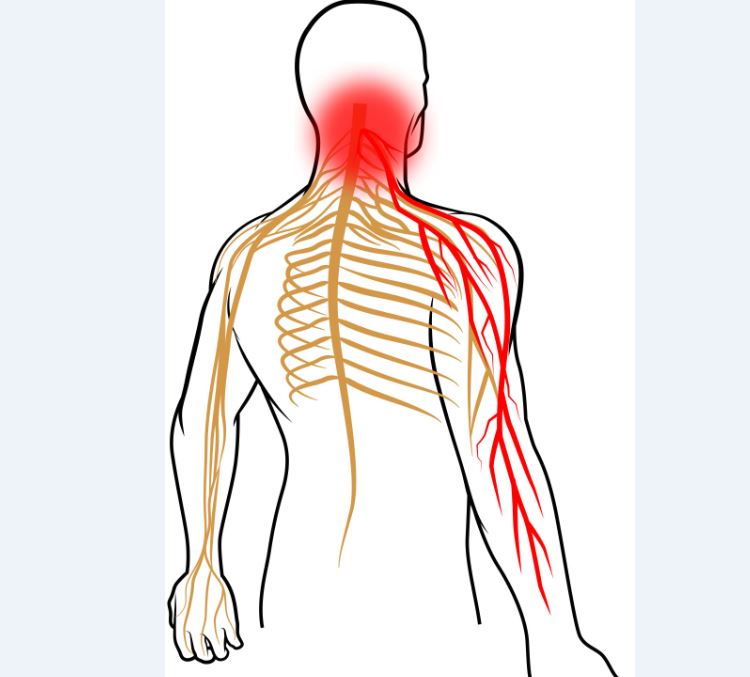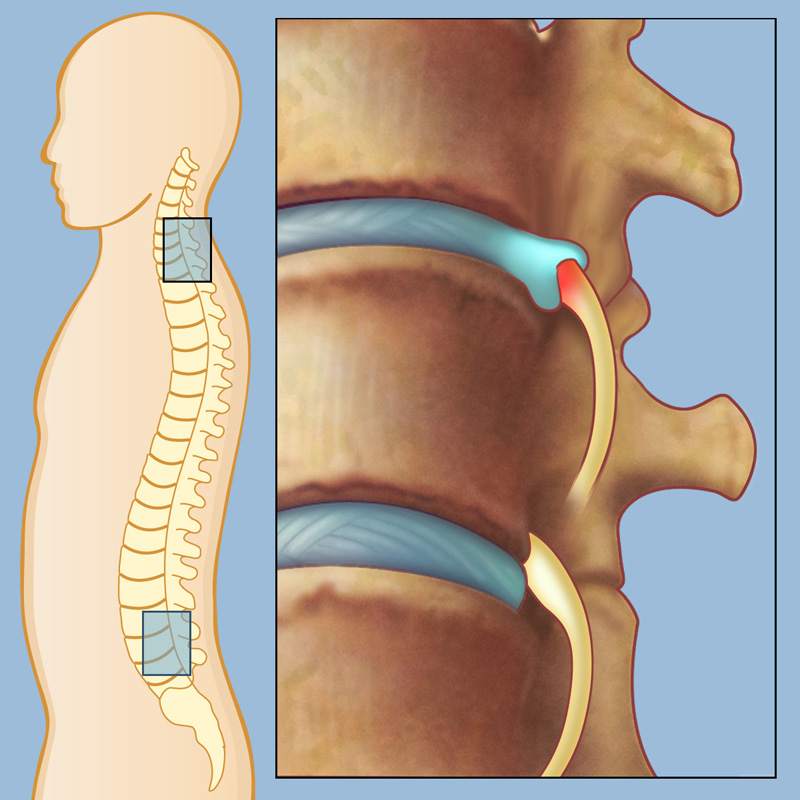The spine is made up of many bones called vertebrae, and the spinal cord passes through a canal that runs through the middle of these bones. Nerve roots divide from the spinal cord and migrate between vertebrae to different areas of the body. When these nerve roots are pinched or damaged, a condition called radiculopathy occurs.
- Radiculopathy is a range of symptoms caused by pinching nerve roots in the spine.
- Pinched nerves can occur in various locations along the spine (cervical, thoracic, or lumbar).
- Symptoms of radiculopathy differ by location but often include pain, weakness, numbness, and tingling.
- A common cause of radiculopathy is the narrowing of the space where the nerve root exits the spine as a result of stenosis, osteophyte, disc herniation, or other conditions.
- Symptoms of radiculopathy can often be managed with non-surgical treatments, but minimally invasive surgery can also help some patients.
WHAT ARE THE TYPES OF RADICULOPATHY?
Cervical radiculopathy: Cervical radiculopathy is diagnosed when a nerve in the neck is pinched or irritated at the point where it leaves the spinal cord. This can cause shoulder pain, muscle weakness, and numbness to spread from your arm to your hand.
Lumbar radiculopathy: Lumbar radiculopathy occurs in the lower regions of the spine and is accompanied by sciatica. The lower back is the area most commonly affected by radiculopathy.
Thoracic radiculopathy: Thoracic radiculopathy is a compressed nerve that occurs in the upper back, causing symptoms such as tingling, pain, and numbness, and can extend to the front of the body.
WHY CHOOSE SPECIALTY CARE CLINICS FOR TREATMENT?
- There are surgical and non-surgical treatments for radiculopathy.
- Our doctors first consider non-surgical treatments. If you need surgery, see if minimally invasive surgery is right for you.
- Our doctors treat all types of nerve roots, including both chronic and acute forms of cervical radiculopathy (neck), lumbar radiculopathy (lower back), and thoracic radiculopathy (upper to mid back).
- Our spine specialists are trained and equipped to treat the most complex cases of radiculopathy.
- Treatment is important, but so is recovery. A customized rehabilitation plan allows you to get back to your favorite activities after spinal surgery.
HOW IS RADICULOPATHY DIAGNOSED?
A careful physical examination and medical history are the first steps in diagnosing radiculopathy. Depending on where the symptoms are, doctors will examine the neck, shoulders, arms, and hands.
Your healthcare professional will check for:
- Numbness and loss of sensation
- Muscle reflexes
- Muscle strength
- Posture and curvature of the spine
Other diagnostic tests recommended by doctors include:
X-rays show the placement of bones along the neck and identify disc stenosis or damage. Spine MRI or spine CT scan to identify osteophytes and ridges or disc herniations compressing nerve roots or spinal cord. Electromyography to determine the exact nerve roots involved.
HOW IS RADICULOPATHY TREATED?
Certain types of radiculopathy can be treated with nonsurgical treatments. These treatments include:
- Physical therapy to strengthen the back muscles and core for better spinal support.
- Medicines that reduce pain and inflammation, such as pain relievers, muscle relaxants, and anti-inflammatory drugs.
- Steroid injections or oral steroids reduce swelling and inflammation around nerve roots.
- Modification of activity to prevent worsening of pain.
- Surgical treatment of radiculopathy focuses on physically removing the tissue that is contracting the nerve root. This includes removing all or part of the herniated disc (discectomy) or widening the opening where the nerve root exits the spine (foraminotomy). Spinal fusion may also be required to stabilize the spine by fusing multiple segments together.
WHAT ARE THE SYMPTOMS OF RADICULOPATHY?
When the nerve root is compressed, it becomes inflamed. This causes some unpleasant symptoms such as:
- Severe back, arm, leg, or shoulder pain that is become worse by certain activities, even as simple as coughing or sneezing
- Weakness or no reflexes in arms or legs
- Numbness, “tingling” or other abnormal sensations (paresthesias) in the skin of the arms or legs
- Specific symptoms depend on the location of the spine where the nerve root is pinched. However, it is also possible to have no symptoms at all or have periodic flare-ups of symptoms.
WHAT ARE THE CAUSES OF RADICULOPATHY?
Radiculopathy more often occurs with aging. As the body begins to age, the discs in the spine begin to degenerate and start to bulge. The discs in the spine also begin to dry and harden. The body reacts to these dynamics by producing bone spurs that strengthen the intervertebral discs. Unfortunately, this narrows the exit of the nerve root and the nerve is pinched.
Radiculopathy is usually caused by:
- Arthritis
- Herniated discs
- Spondylosis
- Bone spurs
At Specialty Care Clinics we provide diagnosis, treatment and management of chronic and acute spinal disorders, from the most common to the most complex.



